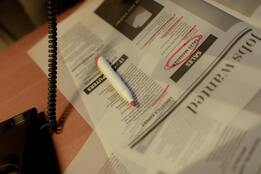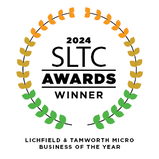|
Congratulations! You've taken the first step in finding a new job by tailoring your CV and writing a killer covering letter. But now comes the dreaded interview process.
Job interviews can be nerve-wracking, especially when you're trying to showcase your skills and experience to a potential employer. Don't let anxiety and sleepless nights get the best of you! The key to success is preparation, and the job description holds the clues to the competencies and experiences the recruiter is looking for. In this blog, we'll walk you through the STAR technique, a well-known method for structuring your answers to competency-based questions in a clear and concise way. Remember to keep your responses short, avoid jargon, and focus on your individual role and actions. By identifying work experiences and applying the STAR acronym (Situation, Task, Action, Result), you'll be well prepared for any interview form, confident in your ability to showcase your skills and experience and be able to impress the recruiter with specific and quantifiable results. What is the STAR technique? The STAR technique is a method of answering behavioural interview questions by providing specific examples of how you handled a particular situation in the past. Each letter in the acronym represents a different part of your response: Situation: Describe the situation or problem you faced Task: Explain the specific task or challenge you were given Action: Describe the actions you took to address the situation or task Result: Explain the outcome or results of your actions The purpose of the STAR technique is to provide structured and detailed answers to interview questions, giving the interviewer a better understanding of your abilities and how you approach challenges. How to use the STAR technique
Let's use an example question to demonstrate how to use the STAR technique Question: "Tell me about a time when you had to handle a difficult customer." Listen carefully: The interviewer is asking for an example of how you handled a difficult customer in the past. Identify a specific example: Think of a situation where you had to deal with a customer who was upset or difficult to work with. So, you could respond as follows:-
Remember to provide specific details about the situation, your actions, and the results. Here are my 4 tips for using the STAR technique effectively
In conclusion, the STAR technique is an effective method for answering behavioural interview questions and showcasing your skills and experience to potential employers. By breaking down your responses into four key parts - Situation, Task, Action, and Result - you can provide structured and detailed answers that give interviewers a better understanding of your abilities. Remember to practice using the STAR technique before your interview, tailor your answers to the job requirements and company culture, and be honest and specific in your responses. By following these tips and using the STAR technique effectively, you'll be well on your way to interview success. Good luck with your next interview!
0 Comments
Congratulations if you have got an interview, be proud! Statistics today show that only about 2% of applicants receive an interview and making it this far is impressive. Are you sat there worrying about how you will demonstrate your skills, capability and experience to the interviewers? This blog will give you some hints and tips on how to show that you are the right person for the role. #1 Research the Company Often you will be asked what you know about the company usually through a question such as “What do you know about the Company?”. The interviewer is looking to see that you are you curious about the company, ask the right questions and know how to ask the right questions. Tip 1: Look at the company values, mission statement, company news, board reports and blog posts so that you can demonstrate that you are fully aware of what makes the company different and how you would apply your qualifications and interest not just to the job, but also to the company as well. #2 Research the Interviewer Find out a little bit about the interviewer or hiring manager through LinkedIn. Do you have any shared interests or connections? Photo by George Milton from Pexels Tip 2: Take a look at the profile prior to the interview but I would recommend holding off connecting until after. #3 Review the Job Description prior to attending the interview Look at the skills required – how do your skills align to these and think of some examples where you have excelled at this. Tip 3: Create a table with the following headings to assist you in reviewing the job description.
#4 The length of your responses – remember to be concise A general rule is to speak for no less than 30 seconds and no more than 2 minutes per answer. Photo from Pexel Tip 4: Consider using STAR & CARE when responding to answers (see section later on #5 How to handle the introductory questions often asked 1. Tell me about yourself Rather than giving a long-winded answer and risk rambling when asked this question consider responding by saying “I’ve had a lot of different experiences in my career, where would you like me to start?” 2. Why did you apply for the role? Remember your research on the company and job description. The interviewer wants to give you the opportunity to show your wisdom, insight and understanding about the job. Ensure you show:-
3. What are your goals over the next 5 years? Focus on the value this role has on your career: how it will help to develop your skills and how you are passionate about helping the company to achieve its objectives. Photo by Oziel Gómez from Pexels Tip 5: Remember an interview is a 2-way process! When answering the question on your goals it is perfectly acceptable to ask to interviewer at the end of your response what growth path they see for the role. #6 Owning the Interview Start the interview as you mean to. You need to show the interviewer why you are the best person for the job. 1. Express your appreciation for the opportunityFor example, “I’ve been really looking forward to this meeting today. I think that <insert company name> is doing great work in <insert particular field, work or project> and I am really excited by the prospect of being able to contribute”. 2. Prepare 3-5 key selling points in mind
3. Anticipate any questions around gaps in your knowledge or experienceFor example, “I know you may be thinking that I might not be the best fit for the position because (insert reservation) but you should know that (why they shouldn’t be overly concerned). 4. Pause before answeringWhat are they really looking for you to answer. If you are not sure about a question it is perfectly fine to ask “did you mean?” or “could you rephrase the question”. Tip 6 : You must sell yourself in creative ways and every answer you give should be tied with how it will benefit the company or the job. #7 Shifting your answers from operational responses to more strategic thinking if applying for management roles This is very much about showing your ability to look forward, encompassing both internal and external factors and setting a course of action for the business to yield the best results. 1. Think strategically
2. Talking strategically
3. Influence
4. Be open to criticism
Photo from Pexel Tip 7: Rather than only thinking short-term and focusing on what’s right in front of you, consider long-term, big-picture questions. This will expand your thinking and help you gain a broader perspective.
#8 Follow-up after the interview Many people fall into the trap of thinking that your work is done once you leave an interview. In a highly competitive recruitment market that exists in some sectors, it is important to stand out and demonstrate that you serious about the role. Send an email to the interviewers within 24 hours to re-iterate your passion for the role. Photo by Cup of Couple from Pexels Tip 8 : An example of what you could send can be found below:-
Dear<name>, Subject: – Interview on <Date> at <Time> Thank you for your time <yesterday / date of interview>. It was a pleasure speaking with you about <insert job title> role. I am very excited about the opportunity to join <insert company> and making a difference in <insert details>. I particularly enjoyed learning more about <insert any specifics or stand out from interview>. I'm convinced that the position is a perfect fit for this stage in my career and that my experience, qualifications and strengths will allow me to fulfil the job requirements effectively and support your company’s objectives. I very much looking forward to receiving an update from you. Also, feel free to ask me any follow-up questions that may have come up since we last spoke. Looking forward to hearing from you, Kind regards Name You submitted your CV or application form and have now been invited to a job interview. Help … what next? This blog will give you some pointers about what to expect and what you need to do to prepare for a Job Interview.
An Overview of Job Interviews Job Interviews are an important part of any recruitment process. But what are interviewers actually looking for?
Shining in a job interview is very much about preparation and planning beforehand and ensuring that your personality shines through. What are the different types of Job Interviews?
How to prepare for a Job Interview Should you just wing it or do you need to do some preparation? To be successful for a job interview it is important for you to complete the following:-
Tips for face to face interviews Remember that first impressions count. Wear something professional and appropriate but not uncomfortable. Your handshake is important, so look the interviewer in the eye and shake firmly. A smile will often help too! Tips for telephone interviews Just because someone can’t see you doesn’t mean that you can’t dress up or smile. This might help put you in the right frame of mind to respond. Tips for answering questions Don’t panic and be yourself Listen carefully to the question. If you are unsure of how to answer, or missed part, don’t be afraid to ask the interviewer to repeat it. Don’t try to fit your prepared answer to the question if it won’t work, take a second to think of a more appropriate reply. Just remember the essentials of a good Job Interview E ENGAGE B BRAIN B BEFORE O OPENING M MOUTH
Questions at the end of the Job Interview Come prepared with some questions to ask at the end of the interview, such as:-
It will show the interviewer that you are interested and help you to visualise what it would like to work there. In summary, preparing for a Job Interview is as important as completing your CV or application form. Preparation is key to demonstrate that you are the best person for the role. If you would like some support in preparing for a Job Interview email me today at [email protected] and I’ll help you get started. |
ServicesCV Support
LinkedIn Support Additional Services - Job Applications Additional Services - Interview Coaching Free Resources Career Essentials Shop Blog Podcast |
|
📸 All photos of Kathryn "The Career Owl" are taken by the amazing Photographer Katie Needle
© Copyright 2024 The Career Owl. We are the owner or licensee of all intellectual property rights in our social media posts / anything else we publish (for example the copyright and any rights in the designs, layout, photographs, images, text and content). They are protected by copyright. You must not change, copy, reproduce or translate anything within our social media posts / anything else you publish without our consent. You are not permitted to license, sell, rent, lease, transfer, assign, distribute, exploit or otherwise make our social media posts / anything else you publish available to any third party such as by posting on your own social media accounts.”










